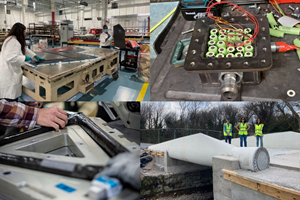Introducing the new HPC
If you’ve been involved in composites design and manufacturing for even a modest period of time, I’ll bet this has happened to you: You have an established composite product or structure that’s been in the market and performing well for a number of years.
If you’ve been involved in composites design and manufacturing for even a modest period of time, I’ll bet this has happened to you: You have an established composite product or structure that’s been in the market and performing well for a number of years. The temptation is to lean on that old adage: if it ain’t broke, don’t fix it. Yet, after several years of service, the design has begun to show its age — what was state-of-the-art in terms of materials selection and molding technique at the product’s birth is now a little dated. It’s decided that this tried-and-true product that has so faithfully performed for so long needs design tweaks to improve production- and cost-efficiency and product performance. You start tweaking — adding a radius here, reorienting a ply there — and before you know it, your tweak has turned into a full-scale redesign. But the result is a product that is far lighter, stronger and performs better than the original — an obvious maturation that represents all that composites have to offer.
Which leads me to the new HPC you’re holding in your hands. Since its birth in 1993, HPC has faithfully adhered, with almost no variation, to one typeface for its articles, one headline typeface and one layout and design standard. Aesthetically, the magazine has remained remarkably consistent by any publishing standard. This is important, as you can imagine, for any magazine that (like a composite product) is looking to establish a place in the market. I think it’s fair to say that HPC has established a strong reputation as a top performer in the composites industry and that it, therefore, deserves to be the best it can be.
It was with this in mind that the HPC staff sat down a few months ago and started thinking about ways to evolve the look and feel of the magazine to carry it one step further in its aesthetic maturation. The goal, of course, was and is to retain those qualities that have made HPC so well respected over the years — strong, technically sound writing and timely composites product information — while improving the way the text, graphics and images are displayed. We thought, at first, that the changes would be modest — remember, if it ain’t broke, don’t fix it. As we pursued these minor updates and upgrades, however, it became apparent that we had been presented an exciting opportunity for a more comprehensive redesign. From there, what you see here took shape.
All of the editorial content you’ve come to know and love is still here: Focus on Design, Inside Manufacturing, Market Trends, Testing Tech, News, New Products and Applications. On top of that, we’ve developed this year a new occasional story type called Work in Progress, which will allow us to report on not-quite-ready for primetime technologies, designs, products and processes that we think are interesting, applicable and should be on your radar. Also, at the end of the magazine, right after Focus on Design, you’ll find a new column called Out of the Mold. On this page, you’ll read opinions, insights, and alternate perspectives from other HPC editors, contributing writers and industry insiders.
All of this great content is wrapped up in a new layout that we hope you will find clean, attractive and easy to read. We’ve changed the typeface in our articles and headlines, updated our treatment of photos and captions, and have integrated other graphic elements designed to help you navigate the pages of HPC. Our art staff spent many hours developing this new look and feel, and I think they’ve done an excellent job — kudos, in fact, go out to the entire HPC team that ushered this redesign along. So, I hand this tried-and-true product back to you and hope you like the new HPC. As usual, I welcome any feedback you want to send my way.
Related Content
As 2023 begins, a look back at trending CW topics in 2022
With 2022 now behind us, CW’s editor-in-chief Jeff Sloan takes a look at the CW stories last year that received the most reader attention.
Read MoreLooking at composites through the lens of U.S. history
When you’re a tourist with a background in writing for manufacturing it’s impossible not to notice all of the ways in which composites have resulted in significant milestones in the U.S. — historically and in the present.
Read MoreBack in the composites saddle
The CompositesWorld team looks ahead to upcoming composites industry events and opportunities for the remainder of the year.
Read MoreThe real value of CompositesWorld
Will CW editor-in-chief Jeff Sloan soon be replaced by ChatGPT? Probably not before he retires, but it’s fun to consider the possibility.
Read MoreRead Next
VIDEO: High-volume processing for fiberglass components
Cannon Ergos, a company specializing in high-ton presses and equipment for composites fabrication and plastics processing, displayed automotive and industrial components at CAMX 2024.
Read MorePlant tour: Daher Shap’in TechCenter and composites production plant, Saint-Aignan-de-Grandlieu, France
Co-located R&D and production advance OOA thermosets, thermoplastics, welding, recycling and digital technologies for faster processing and certification of lighter, more sustainable composites.
Read MoreDeveloping bonded composite repair for ships, offshore units
Bureau Veritas and industry partners issue guidelines and pave the way for certification via StrengthBond Offshore project.
Read More













.jpg;maxWidth=300;quality=90)








